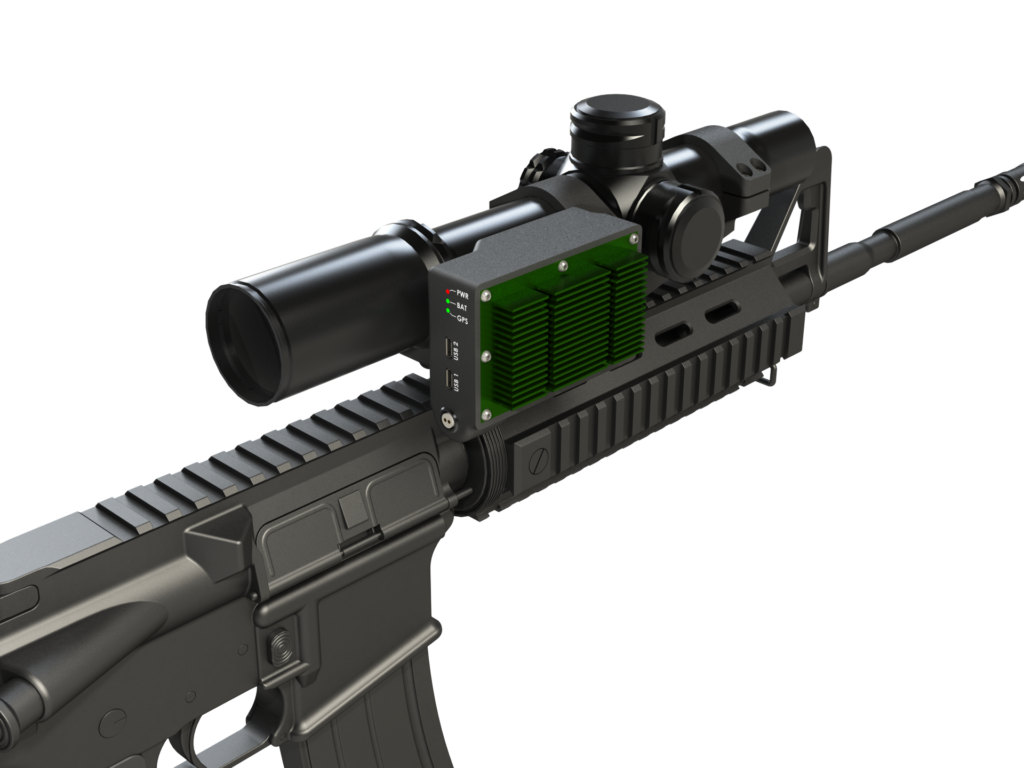
Close-up of the Army’s proposed “eBullet” training system attached to an M4 carbine
WASHINGTON: For 40 years, US soldiers have trained using a militarized form of laser tag, called MILES. Those days are drawing to an end. The Army replacement, called eBullet, calculates true ballistic flight paths to within a seventeenth of a degree and allows for a much greater array of weapons to be simulated.
The new system superimposes simulated trajectories, explosive blasts, and other virtual effects on real-world terrain, adjusts for real-world weather factors like wind and temperature, and electronically notifies soldiers whether they’re been “killed” or “wounded.”
The new system promises much greater realism since real bullets don’t behave like beams of light, which follow perfectly flat trajectories and can’t penetrate smoke, tents, or even leaves. And it can simulate a much wider array of weapons than MILES.
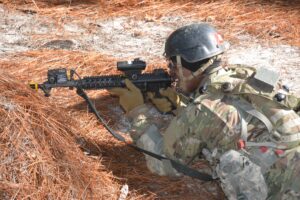
A soldier uses MILES, a laser-tag-like system.
eBullet will not only simulate the flight paths of rifle rounds more accurately than a straight-line laser: It can simulate the arcing trajectories of such vital infantry weapons as grenade launchers and mortars, which MILES can’t cope with at all. Future upgrades could simulate the propagation of radio-frequency jamming, poison gas, and biological agents.
“MILES has not been able to replicate or simulate many weapons systems,” said Frank Tucker, the live-training technology lead for the Synthetic Training Environment team at Army Futures Command. “It’s only been able to simulate 60 percent of the current inventory of weapons.” Worse, he said, it can’t simulate enemy weapons or potential future weapons at all.
But with eBullet, Tucker told me in an interview, adding a new weapon could be as simple as tweaking a few factors in the model to create a “digital twin” of an existing or potential technology. “The Army now can dream up a new weapons system and synthetically deploy it in a training exercise to see how it works or doesn’t work, without bending metal,” he said. “It can just simply be a model that’s embedded in e-bullet.”
For more complex phenomena, like electronic or biochemical warfare, the service could just take existing Army effects-propagation models and plug them into the eBullet suite. “You can do some very, very interesting things we never had in live training,” Tucker said. “We’ve never been able to train this stuff — never.”
What’s more, the first product using eBullet technology has applications in combat, not just training. “The normal process for aiming a mortar, it’s a very manual approach,” Tucker said. “You have to go out and put out aiming stakes. It takes up to five minutes to set up and start aiming.” And, he told me, mortar crews need to carry a 40-pound, $60,000 gyrocompass called a Talon II to ensure everything’s correctly aligned.
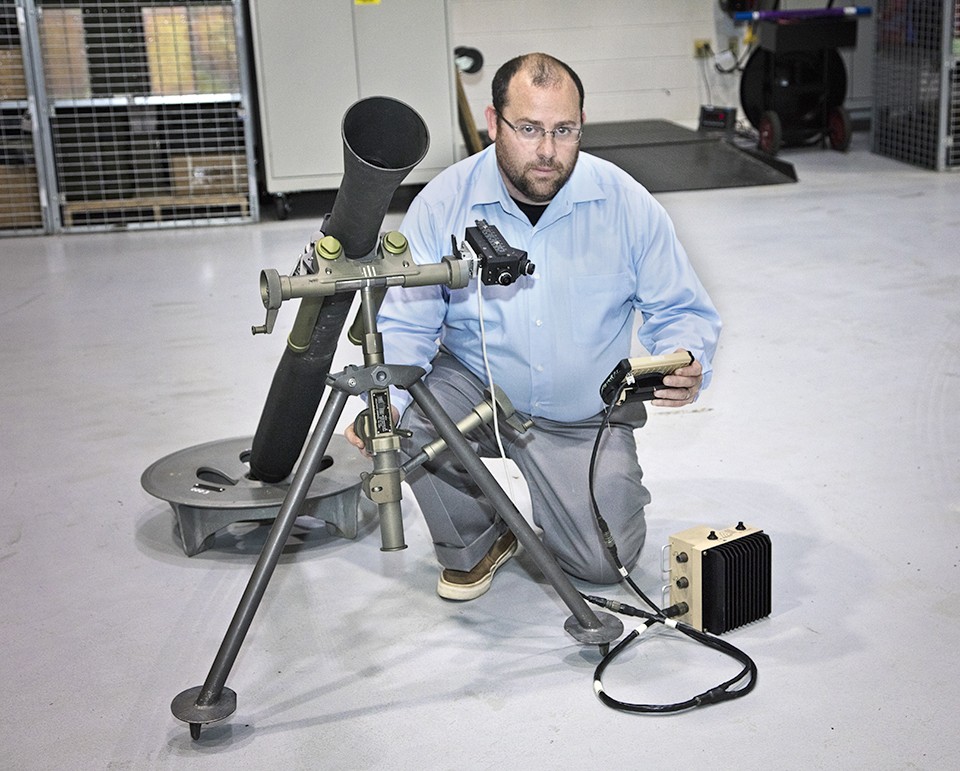
The eBullet technology is part of the Army’s new system for aiming mortars in combat, WULF (Weaponized Universal Lightweight Fire Control)
By contrast, the new system, called WULF (Weaponized Universal Lightweight Fire Control), weighs about 10 pounds. It uses computer vision and digital maps to determine exactly where the weapon is aligned relative to the terrain, then calculates the proper settings for both elevation (up/down) and azimuth (left/right). The mortar team reads the settings off their handheld device, “and all they do is they crank twice,” Tucker said. “Instead of five minutes, it takes less than one minute to aim a mortar.”
In combat, saving four minutes could save lives.
How accurate is this system? It’s twice as good as the existing Talon II, Tucker said, with errors under one milliradian: That’s less than one-seventeeth (0.58) of one degree.
Now, there’s a crucial caveat here. To get that accuracy in real life, your digital map has to be accurate – down to the precise locations of trees and trenches, modeled in three dimensions. Otherwise eBullet’s simulated trajectories won’t correspond to actual flight paths in the real world.
That’s why the Army is investing heavily in a global 3D database known as One World Terrain. Since the landscape constantly changes – due to new construction, mudslides, or, in war zones, large explosions – that database will have to be constantly updated. The Army’s developed technology to let drones or soldiers with video cameras scan new terrain features, using photogrammetry software to automatically turn the images into map updates.
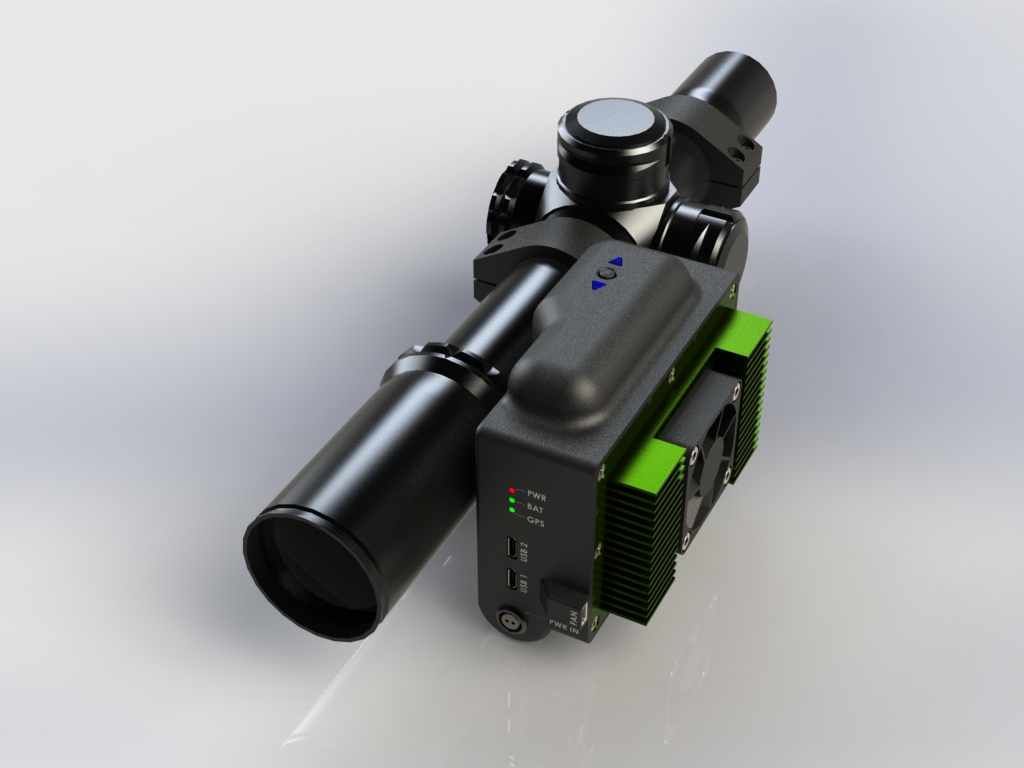
Close-up of the Army’s proposed “eBullet” training scope
From Mortars To Rifles To AI
The mortar-aiming system will be the first eBullet application, not only because of its tactical and training value, but because a device mounted on a mortar can afford to be heavier than one fitted to, say, a rifle. As the Army matures the technology, Tucker said, it’ll both scale it for vehicle-mounted weapons and miniaturize it it to fit on smaller and smaller infantry weapons:
- eBullet on the 81mm mortar will achieve what’s called Technological Readiness Level (TRL) 6 – prototype demonstration in a realistic environment – in 2021.
- Fiscal year 2022 (which begins Oct. 1st, 2021) will see eBullet become available for heavy-duty bipod-mounted weapons, like the M240 medium machinegun, the M249 Squad Automatic Weapon, and the Mark 19 rapid-fire grenade launcher.
- The next wave is handheld weapons, like the M4 carbine and the M320 single-shot grenade launcher. Timing on these applications is still TBD, Tucker told me.
- The hardest challenge of all, Tucker said, will be fitting eBullet’s sensors on a pistol.
Not all of eBullet’s components have to fit on the weapon itself, however. Much like MILES, it’ll typically have two modules: one that goes on the weapon to measure precisely where it’s pointing – azimuth, eleventh, attitude, et al – and one worn on the soldier’s body.
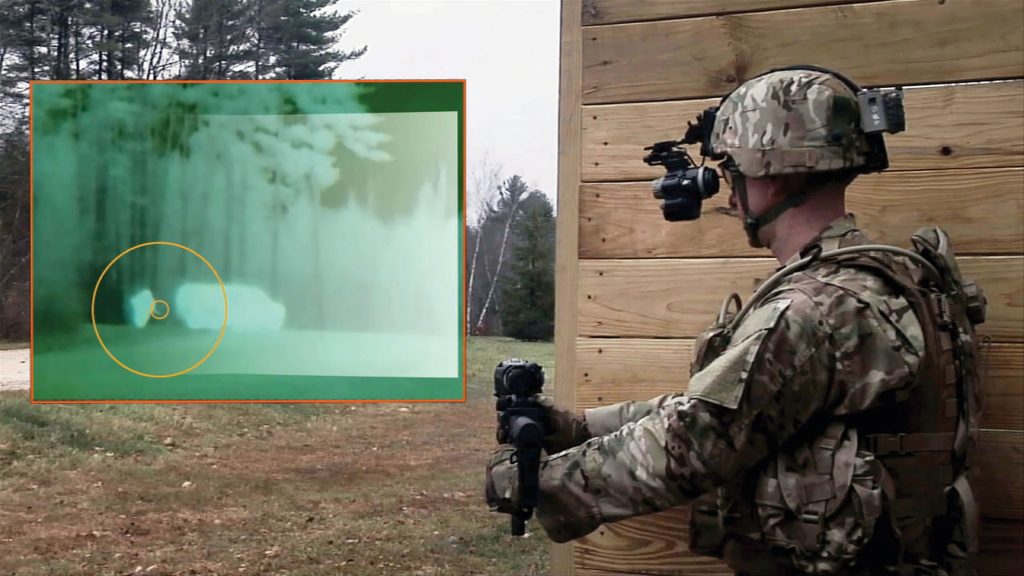
The inset image shows what the soldier can see through the wirelessly linked ENVG-III goggle and FWS-I gunsight.
For MILES, the weapon-mounted module is a laser emitter that’s only used in training. eBullet, by contrast, will use, whenever possible, the new FWS-I digital gunsight that the Army is already issuing to frontline troops. Like the WULF aiming system for mortars, FWS-I’s primary application is combat, not training. It calculates precisely where each shot will go and transmits that data to the soldier’s augmented-reality goggles (either the new ENVG-B or the forthcoming IVAS), which then superimpose a digital cross-hairs over the real-world target. The difference is that, in training battles, you don’t fire an actual bullet, just a simulated one.
Then there’s the body-mounted module. Whereas MILES’ chest-mounted unit is merely a laser receiver, which emits a high-pitched whine whenever it detects the soldier has been hit, the eBullet wearable module will house the system’s computer brain. “It’s doing all the computations,” Tucker said.
When the soldier fires, the “lethality” simulator in his eBullet computer calculates a host of factors – the exact orientation of the weapon, the muzzle velocity, wind direction, ambient temperature, even the grain of the specific ammunition being simulated – and uploads a data packet to the training network. If the software determines another soldier is in the flight path of the virtual bullet, or in the blast zone of the virtual grenade or mortar round, that soldier’s computer downloads the lethality data, compares it to a “vulnerability” simulator that models the effects of such things as body armor, and then tells the soldier if they’re killed or injured in a specific way.
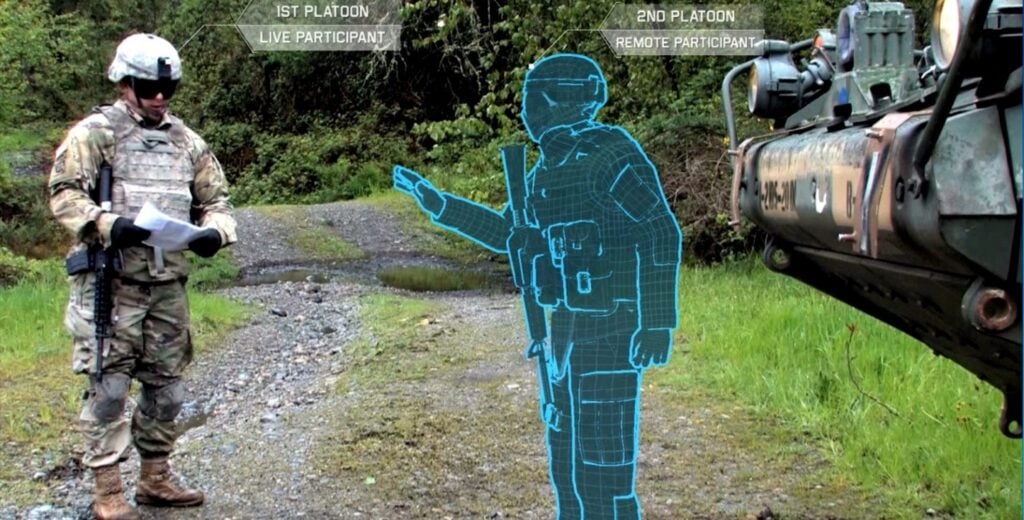
An Army soldier interacts with a virtual comrade in an “augmented reality” simulation.
The simulation doesn’t stop there. MILES can’t tell you if your shot hit or missed, and it can’t replicate real-world techniques like tracer rounds or “walking” machinegun fire onto a target. But if you combine eBullet with the augmented-reality graphics on the IVAS goggles, Tucker said, you could superimpose virtual dust plumes, tracer rounds, and explosions on the wearer’s field of view, giving instant and realistic feedback.
Then, after the training exercise is over, you can upload all the data – the simulated gunshots and explosives, hits and misses, deaths and casualties – into a high-powered computer for analysis. This is potentially the biggest benefit of eBullet, because it allows the Army to assess soldiers’ performance with unprecedented rigor, apply big-data techniques, and even train artificial intelligence.
Today, “live training is very subjective,” Tucker argued. MILES tells individual soldiers if they’ve been hit, but it doesn’t record or share that data. Ultimately, it’s up to experienced humans, known as observer-controllers, to monitor the training battles at the Army’s Combat Training Centers and assess each unit’s performance for detailed after-action reviews.
But with eBullet, “each trigger pull is a data event, and we track every single bullet,” he said. “It captures every detail of a tactical engagement, [so] you can literally replay it, digitally, in a game engine, and it becomes a movie… You can zoom in on something, you can pan and tilt.”
eBullet not only generates a lot of data. Tucker said It also tags and labels that data as it generates it – this is a bullet trajectory, this is shooter’s location, this is a target – so it can be easily digested by big-data analytics and machine-learning algorithms. (By contrast, real-world reconnaissance data often requires extensive processing by human analysts before it’s tidied up and intelligible to machines). That lets commanders analyze their troops’ performance with the same kind of statistics that elite sports coaches now have on their players.
“The Army needs to get into the age of data analytics, and it isn’t, frankly,” Tucker said. “With this system being digital, we now have the foundation of data analytics and the ability to extract patterns and meaning from the data.”






















